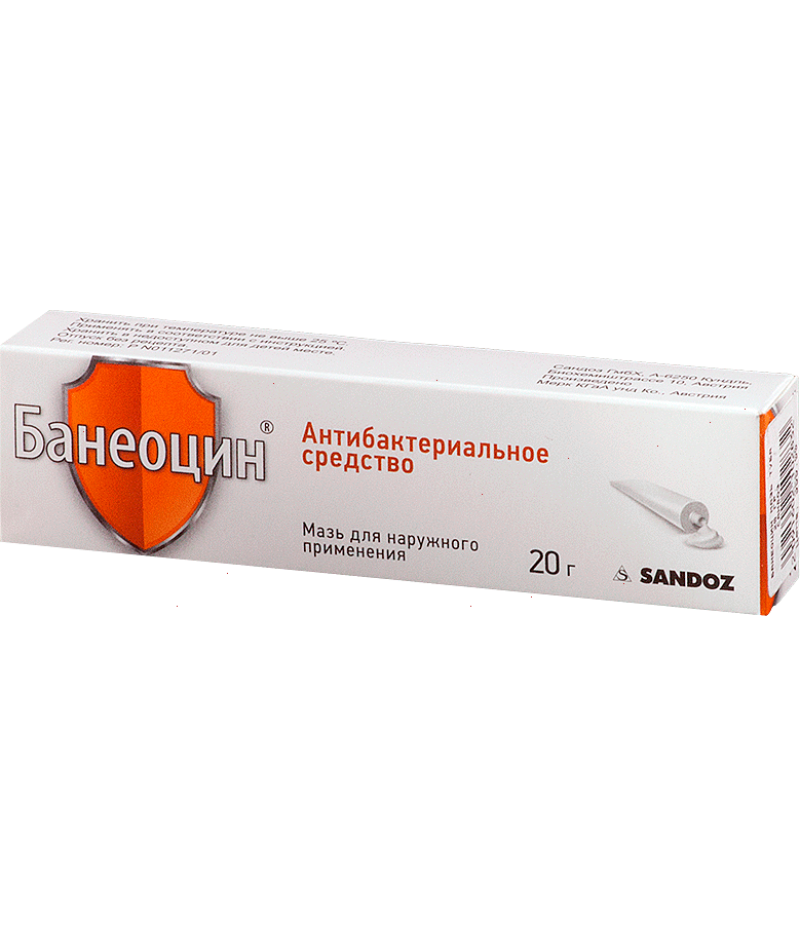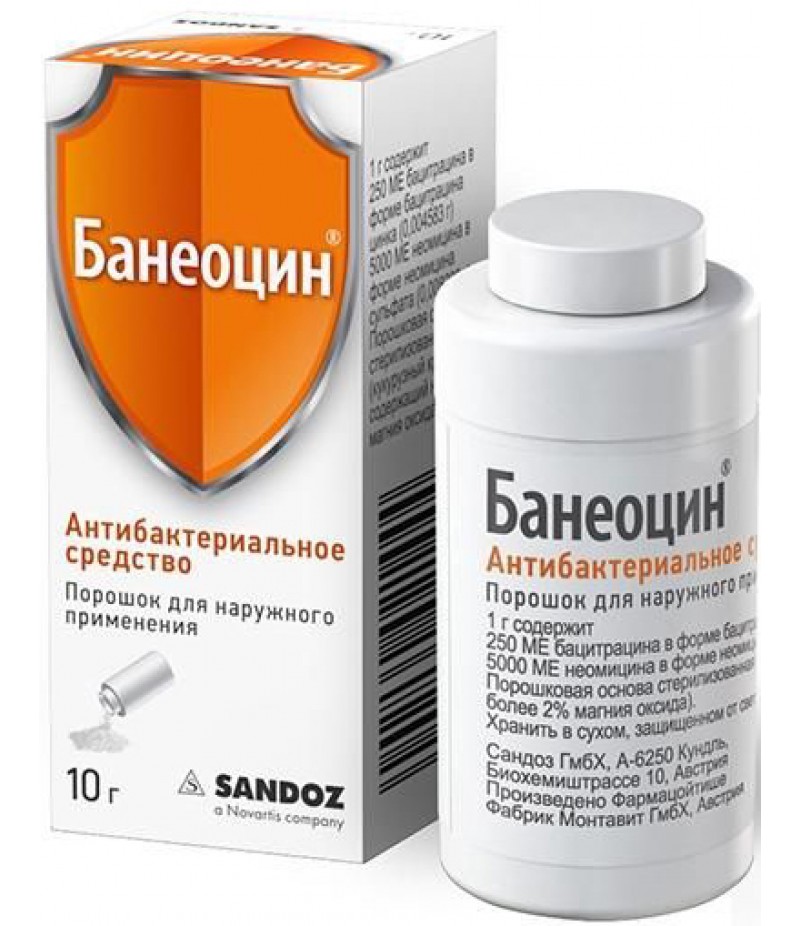Baneocin ointment 20gr
- $21.19
- 3 or more $20.99
- Availability:In Stock
Instruction for Baneocin ointmentYou can buy Baneocin ointment on this pageCompositionIn 1 g of the drug contains: sulfate neomycin - 5000 IU; zinc bacitracin 250 IU.As auxiliary substances are ..
Tags: ointment
Instruction for Baneocin ointment
You can buy Baneocin ointment on this page
Composition
In 1 g of the drug contains:
sulfate neomycin - 5000 IU;
zinc bacitracin 250 IU.
As auxiliary substances are lanolin and paraffin, which has a white color and a soft consistency.
Pharmacokinetics
As a rule, the drug is well tolerated by the body and is not absorbed even by the skin with the presence of lesions. However, in this case, a high degree of concentration of neomycin and bacitracin will be present in the skin.
Tissue tolerance of Baneocin ointment is excellent. Partial or complete loss of active properties of its properties, due to interaction with tissue components, blood and other biological products, is not observed.
If Baneocin ointment is applied to the vast surface of the skin, it is necessary to take into account the possibility of absorption of the drug and the development of the consequences of this process.
pharmachologic effect
Baneocin ointment is a combined antibiotic that is applied only externally and consists of two main active substances - neomycin and bacitracin.
Due to the presence of neomycin, the drug is capable of inhibiting the synthesis of proteins that are inside the bacterial cells. Neomycin is able to exert a detrimental effect on gram-negative and gram-positive microorganisms.
A bacitracin is a polypeptide substance, which allows it to inhibit the synthesis of cell membranes of bacteria. It affects some types of gram-negative pathogens and Gram-positive microorganisms, for example:
staphylococcus aureus;
streptococcus;
beta-hemolytic.
It should also be noted that the immunity of the human body to bacinracin is very rare.
Due to the presence in Baneocin ointment of the two above-described active ingredients, the drug has a wide spectrum of action and synergism to many pathogenic microorganisms.
Indications
This drug is indicated in the presence of infections that are sensitive to such active substances as neomycin and bacitracin.
Baneocin ointment has proven itself in the treatment of focal infections of the skin, for example:
deep folliculitis;
staphylococcus sycosis;
carbuncles (in the process of postoperative therapy);
furunculosis;
paronychia;
Hydradenitis with the presence of purulent accumulations.
Also, the drug perfectly cures of such pathologies as limited bacterial infections of the skin, for example:
burns;
abrasions;
cuts;
dermatosis and eczema (with secondary infection);
leg ulcers;
contagious impetigo.
In addition, Baneocin ointment successfully used:
when performing operations for organ transplantation;
in cosmetology surgery;
as a preventive measure.
The drug can also be used as an additional drug in the postoperative period. With local therapy, it is desirable to impregnate the ointment with gauze tissue for the dressing of various lesions of the skin:
surgical sutures, which heal by secondary tension;
wounds of various etiologies;
infected external auditory canals (bacterial damage).
Contraindications
Disorders of cochlear and vestibular systems.
Expressed violations of the excretory function of the body against the background of the development of renal and / or heart failure.
Excessively extensive lesions of the skin. Otherwise, there may be a development of ototoxic effect and, as a consequence, hearing loss.
Individual intolerance to the body components of the drug.
Increased sensitivity to antibiotics, which belong to the aminoglycoside group.
Possible side effects
With prolonged use of Baneocin ointment in patients, the following symptoms can be observed:
itching;
rashes on the surface of the skin;
dry skin;
hyperemia of the skin.
The listed manifestations of an allergic nature arise in rare cases and occur, as a rule, in the form of eczema of contact type. In about half of cases, these side effects intersect with allergies to other antibiotics of the aminoglycoside series.
It is important to know!
If the ointment is used to treat extensive wound surfaces of the skin, suction of the drug may occur, respectively, complications can occur in the form of:
blockade of neuromuscular conduction;
nephrotoxic effect;
disorders of the cochlear and vestibular apparatus.
Overdose
No cases of an overdose of Baneocin ointment have been reported.
Carefully
Use the drug with caution to patients with the presence of neuromuscular pathologies, for example, severe myasthenia and acidosis. There is a high probability of neuromuscular blockade. If such complications have occurred, it is recommended that you take Neostigmine and Calcium.
If the ointment is used for a long period of time, care should be taken to ensure that the growth of resistant microorganisms is not excessive. If such a situation arises, it is recommended to undergo a course of appropriate treatment.
If the patient has a superinfection, or if allergic reactions appear, the therapy with baneocin ointment should be stopped immediately.
special instructions
If the drug is used in particularly large doses, which are several times higher than recommended, it is necessary to monitor the development of negative symptoms - ototoxic and nephrotoxic effects.
The risk of developing such toxic manifestations increases significantly if the patient has hepatic and renal failure. Therefore, such patients, before and during the therapy with Baneocin ointment, are recommended to undergo certain types of research:
audiometric analysis;
Analysis of urine;
blood test.
Be sure to consult a doctor if:
Deep skin lesions occur;
the drug is used for a long time;
the area of the treated skin is extensive;
the liver and / or kidney function is impaired;
ointment is used to treat children.
Interaction with other medicinal products
The use of Baneocin ointment, in the presence of systemic absorption, together with antibacterial preparations of the aminoglycoside group and cephalosporins, can increase the risk of developing neurotoxic reactions.
In patients who, against the background of Baneocin's absorption, take muscle relaxants, anesthetics or drugs with narcotic properties, there may be pronounced symptoms of blockade of neuromuscular conduction.
Baneocin ointment, concomitantly taken with diuretics (furosemide and ethacrynic acid), can provoke the development of nephro and ototoxic effects.
Dosage and methods of administration
The ointment is applied with a thin, even layer on the affected areas of the skin. In a day, this procedure can be carried out up to 3 times. If necessary, Baneocin ointment is applied under the bandage.
With impaired renal and hepatic function
The use of the drug in hepatic and / or renal failure increases the possibility of developing toxic effects. Before and during the therapy, it is necessary to conduct appropriate studies of urine, blood and acuity of hearing.
Pregnancy and breastfeeding
If the dose of Baneocin ointment exceeds the allowable dose, which is safe for fetal development (during pregnancy) and the life of the child (with lactation), compulsory medical consultation is necessary.
Leave conditions
You don't need a prescription to buy Baneocin ointment.
Term and conditions of storage
Shelf life is 3 years. The drug can not be used after the specified period. Store the ointment at a temperature not exceeding + 25 ° C.


